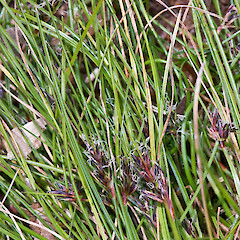Schoenus caespitans
Synonyms
Schoenus apogon var. caespitans (Petrie) Edgar
Family
Cyperaceae
Flora category
Vascular – Native
Endemic taxon
Yes
Endemic genus
No
Endemic family
No
Structural class
Sedges
Chromosome number
2n = 8
Current conservation status
The conservation status of all known New Zealand vascular plant taxa at the rank of species and below were reassessed in 2017 using the New Zealand Threat Classification System (NZTCS) – more information about this can be found on the NZTCS website. This report includes a statistical summary and brief notes on changes since 2012 and replaces all previous NZTCS lists for vascular plants.
Please note, threat classifications are often suggested by authors when publications fall between NZTCS assessment periods – an interim threat classification status has not been assessed by the NZTCS panel.
- Conservation status of New Zealand indigenous vascular plants, 2017 . 2018. Peter J. de Lange, Jeremy R. Rolfe, John W. Barkla, Shannel P. Courtney, Paul D. Champion, Leon R. Perrie, Sarah M. Beadel, Kerry A. Ford, Ilse Breitwieser, Ines Schönberger, Rowan Hindmarsh-Walls, Peter B. Heenan and Kate Ladley. Department of Conservation. Source: NZTCS and licensed by DOC for reuse under the Creative Commons Attribution 4.0 International licence.
2017 | At Risk – Naturally Uncommon | Qualifiers: DP, Sp
Previous conservation statuses
2012 | At Risk – Naturally Uncommon | Qualifiers: DP, SO, Sp
2009 | At Risk – Naturally Uncommon
2004 | Not Threatened
Distribution
Endemic. North and South Islands, from the north-western Ruahines south and east to Cape Palliser, on DUrville Island and eastern Marlborough to the Hunter Hills, South Canterbury.
Habitat
Coastal to subalpine (up to 1100 m a.s.l.). In open ground, and under sparse scrub where it is usually found on damp clay but also in seasonally dry, poorly drained soils, and on ultramafic substrates (and then found around seepages and tarns). Often in short-tussock or silver tussock (Poa cita Edgar) grassland.
Detailed description
Densely tufted, caespitose sedge. Culms numerous, 15–60–(200) mm long, ≤ 0.5 mm diameter, densely packed at base, otherwise rather flaccid, unbranched, glabrous, occasionally finely scabrid just below inflorescence. Leaves 20–600–(800) mm long, usually equal to or greater than the culm length; yellow green to dull green, linear to very narrow-linear, acute, channelled, margins slightly scabrid; sheaths membranous, reddish to red-purple. Panicle of 2–3 mostly densely clustered (rarely distant) fascicles, the terminal usually with sessile to subsessile, densely clustered spikelets, the lower fascicles, shortly stalked, bearing densely to loosely clustered spikelets; bract subtending each fascicle leaf-like, lowest bract overtopping whole inflorescence. Spikelets 3–5 mm long, 1–(2)-flowered; if 2-flowered, the second flower male. Glumes dark red-brown, dull to somewhat glossy, with a prominent cream centre; midrib slightly scabrid; lower 1–3 glumes usually empty, often mucronate. Hypogynous bristles 6, > nut. Stamens 3. Style-branches 3. Nut slightly < 1.0 × 0.5 mm, white with the 3 angles green or yellow, elliptic-oblong, almost globose, obtuse, apiculate, surface when viewed with a lens, minutely cellular, individual cells rather small.
Similar taxa
Schoenus apogon is very similar (and in some treatments S. caespitans is regarded as a variety of it). From S. apogon, S. caespitans differs by its mostly smaller more densely tufted growth habit, culms up to 200 mm long, and ≤ 0.5 mm wide; by the leaves ≥ length of the culms, 1–(2)-flowered spikelets that are 3–5 mm long (in S. apogon the spikelets are 2–4-flowered and 4–6 mm long) and by the red-brown glumes which have a prominent cream centre, rather than mostly red to red-purple or almost black, rarely with a pale cream patch near the midrib. The surface of the nuts of S. caespitans has much smaller, minute cells than S. apogon.
Flowering
August–April
Fruiting
September–June
Propagation technique
Easily grown from rooted pieces and fresh seed. An excellent pot plant. Quite tolerant of dry conditions as well as wet. Requires full sun.
Threats
Not Threatened but not very common either. Possibly qualifies as a Sparse species.
Etymology
schoenus: Rush
Where To Buy
Not commercially available
Attribution
Description adapted from Moore and Edgar (1970).
References and further reading
Moore LB, Edgar E. 1970. Flora of New Zealand, Volume II. Indigenous Tracheophyta: Monocotyledones except Gramineae. Government Printer, Wellington, NZ. 354 p.


